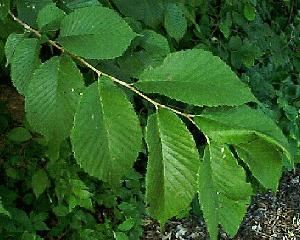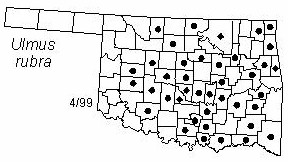
Tree to 18 m (60 ft) tall and 50 cm (18 in) in diameter with broad open flat-topped crown. Bark dark brown, thick, divided into scaly ridges. Twigs light brown, soft hairy, mucilaginous (slippery) when crushed or chewed. Buds brown, red-hairy, large, blunt, with several scales in two rows, no terminal bud. Leaves alternate, elliptical, acuminate, with the two sides of the base very unequal, 10-18 cm (4-7 in) long and 5-7.5 cm (2-3 in) wide, dark green and very rough above, densely soft-hairy below. Flowers in small clusters on leafless twigs, small, greenish or brownish, blooming in late Winter. Fruits in small clusters at leaf bases, nearly round samaras about 15 mm (0.6 in) in diameter, maturing in early Spring soon after leaves appear.
Distribution: Native to about the eastern half of the U. S. and adjacent southern Canada.
Habitat: Well-drained floodplain forests and moist upland forests.
NWI status: FAC
Comment: The dried bark has been used as a cough medicine. Ulmus is the old Latin name for the elms; rubra refers to the reddish wood.
Distribution in Oklahoma: 
BACK
NEXT
RETURN TO INDEX
Last update: 9/21/99
 Go to Oklahoma Biological Survey Home Page
Go to Oklahoma Biological Survey Home Page
 Disclaimer
Disclaimer